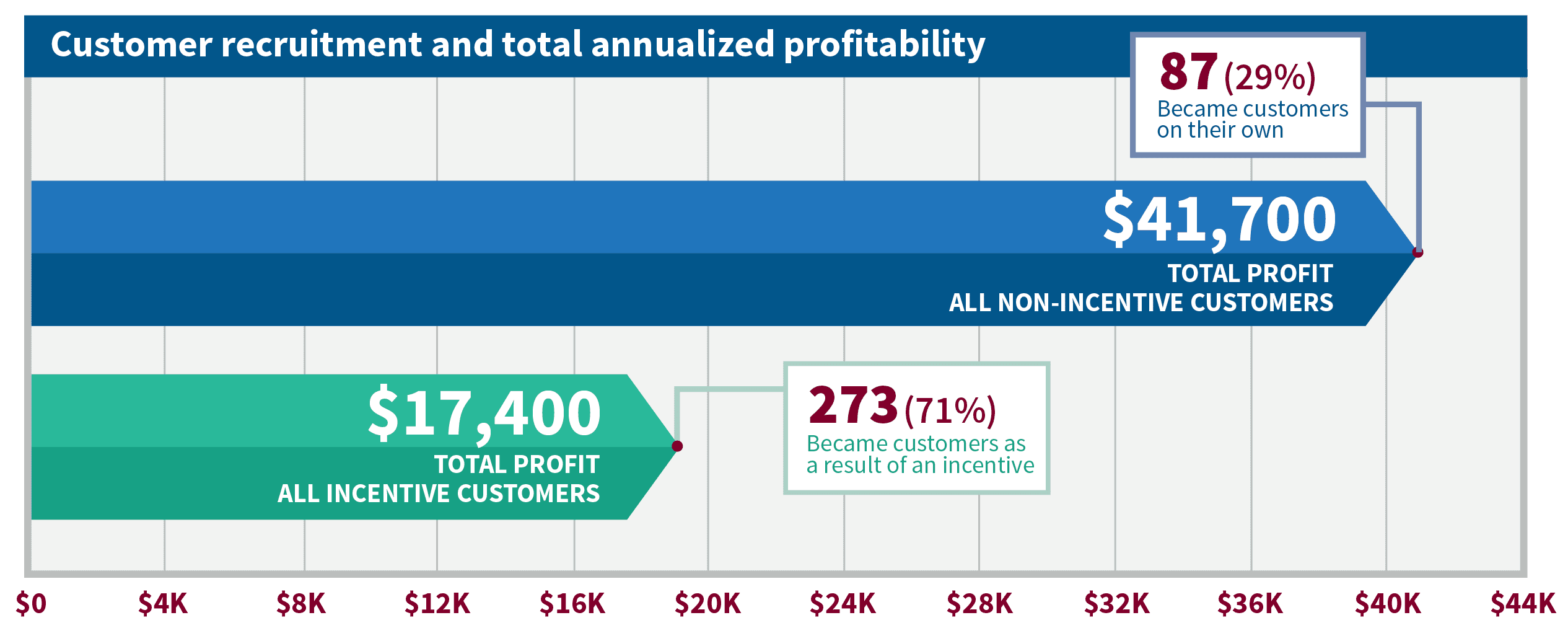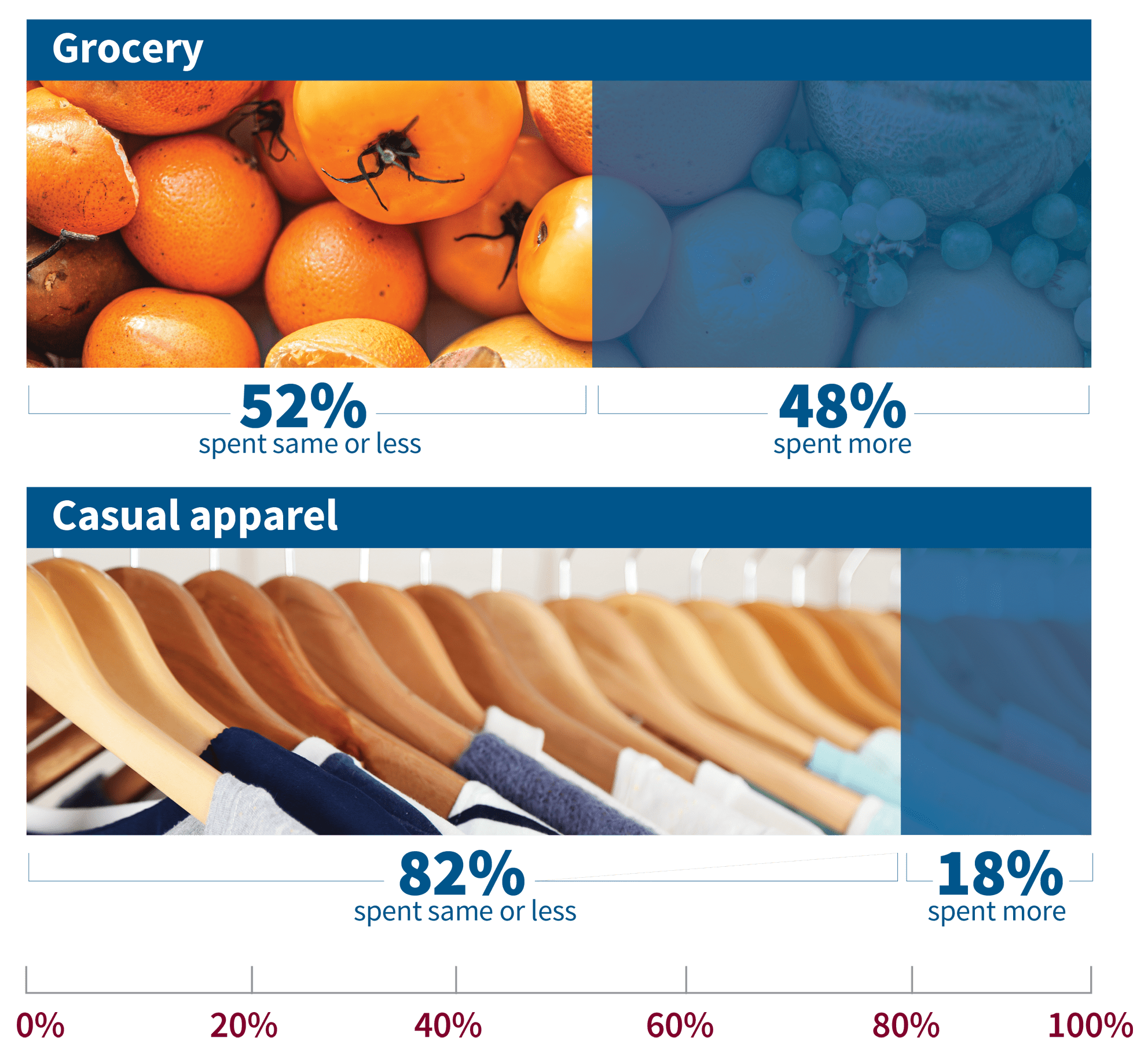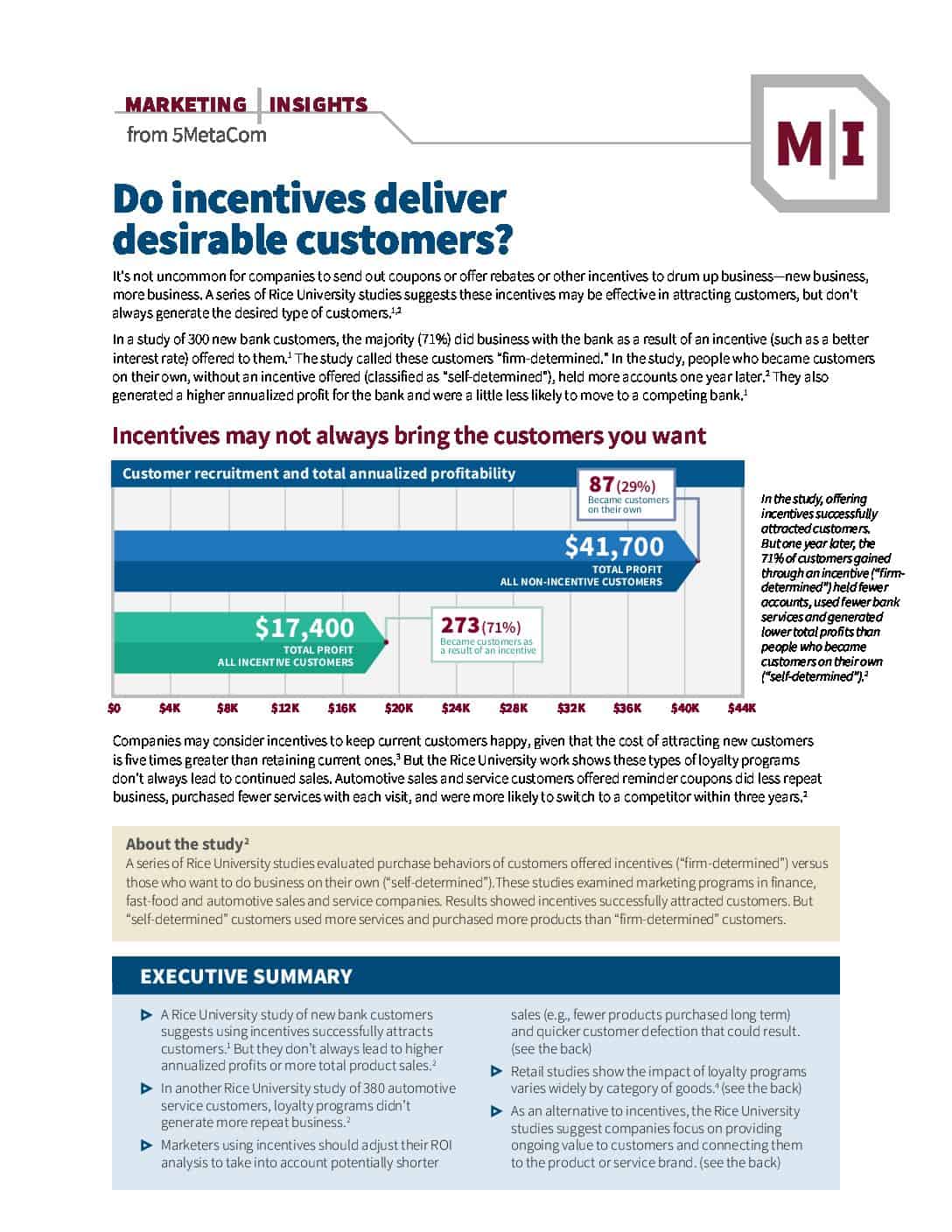Do incentives deliver desirable customers?
It’s not uncommon for companies to send out coupons or offer rebates or other incentives to drum up business—new business, more business. A series of Rice University studies suggests these incentives may be effective in attracting customers, but don’t always generate the desired type of customers.1,2
In a study of 300 new bank customers, the majority (71%) did business with the bank as a result of an incentive (such as a better interest rate) offered to them.1 The study called these customers “firm-determined.” In the study, people who became customers on their own, without an incentive offered (classified as “self-determined”), held more accounts one year later.2 They also generated a higher annualized profit for the bank and were a little less likely to move to a competing bank.1
Incentives may not always bring the customers you want

In the study, offering incentives successfully attracted customers. But one year later, the 71% of customers gained through an incentive (“firm determined”) held fewer accounts, used fewer bank services and generated lower total profits than people who became customers on their own (“self-determined”).2
Companies may consider incentives to keep current customers happy, given that the cost of attracting new customers is five times greater than retaining current ones.3 But the Rice University work shows these types of loyalty programs don’t always lead to continued sales. Automotive sales and service customers offered reminder coupons did less repeat business, purchased fewer services with each visit, and were more likely to switch to a competitor within three years.2
About the study2
A series of Rice University studies evaluated purchase behaviors of customers offered incentives (“firm-determined”) versus those who want to do business on their own (“self-determined”).These studies examined marketing programs in finance, fast-food and automotive sales and service companies. Results showed incentives successfully attracted customers. But “self-determined” customers used more services and purchased more products than “firm-determined” customers.
EXECUTIVE SUMMARY
- A Rice University study of new bank customers suggests using incentives successfully attracts customers.1 But they don’t always lead to higher annualized profits or more total product sales.2
- In another Rice University study of 380 automotive service customers, loyalty programs didn’t generate more repeat business.2
- Marketers using incentives should adjust their ROI analysis to take into account potentially shorter sales (e.g., fewer products purchased long term) and quicker customer defection that could result.
- Retail studies show the impact of loyalty programs varies widely by category of goods.4
- As an alternative to incentives, the Rice University studies suggest companies focus on providing ongoing value to customers and connecting them to the product or service brand.
Customers could take the incentive and run
In a separate study of retail loyalty programs by an international market research firm, results varied greatly. In some cases these programs successfully attracted new customers, enhanced the company’s brand image and increased sales with current customers. In other cases, customers simply took the benefits of the incentive program without doing more business with the company. Or they joined multiple loyalty programs, compared the benefits, and then moved on to the company offering the best promotion at the time.4
Impact of loyalty programs varies widely by category of goods

A retail study showed consumers didn’t necessarily spend more as a result of an incentive.4 However, more frequently purchased commodity categories had a bigger boost in sales with loyalty programs.
Making incentives practical for marketers
Given the varied results in these studies, marketers using incentives should adjust their ROI analysis to take into account the potentially shorter gains in sales and quicker customer defection which may result. Doing so could prevent you from reaching an inaccurate conclusion about the long-term impact of incentives in your marketing efforts. Depending on your category of goods or long-term sales goals, incentives may offer a useful tool. But these studies suggest you may want to consider whether incentives can help you attract the type of customers you find most desirable.
Alternatives to incentive programs or promotions
Incentives give marketers one way to increase sales. These programs can work well. Market share goes up. But the impact of using incentives varies greatly depending on the product or category. Incentives sometimes bring more short-term gains in sales and customer recruitment. So if you’re looking for a way to build more long-term customer growth, the Rice University studies suggest some alternatives to incentives.
- Connect important audiences to your brand, rather than an incentive or promotion. The Rice University research says brand-building programs such as image advertising help attract new “self-determined” customers. Craft your marketing program to ensure your brand communicates effectively to people who would want to and are ready to do business with you.
-
Identify and recruit customers who would likely do business with you on their own. What does that mean? Know your target market and ensure they have sufficient exposure to your brand. And understand what you do and who you’re for. Why? People who want to and are ready to do business with you (“self-determined”) will likely become more long-term, satisfied customers.
-
Bolster long-term relationships with the customers you already have. These people often make up the bulk of your business. It’s easy to overlook (or lose) the customers you already have while focusing on incentives to lure potentially less valuable customers.
1 Dholakia, P. (2005, October). The hazards of hounding. Harvard Business Review, 83(10):20-+.
2 Dholakia, U. (2006, February). How customer self-determination influences relational marketing outcomes: Evidence from longitudinal field studies. Journal of Marketing Research, 43(1):109-120.
3 Kotler, P. (2005, April). Marketing Management, 12th edition. Hoboken, NJ: Prentice Hall.
4 Cigliano, J., Georgiadis, M., Pleasance, D., & Whalley, S. (2000). The Power of Loyalty. McKinsey and Company white paper.
